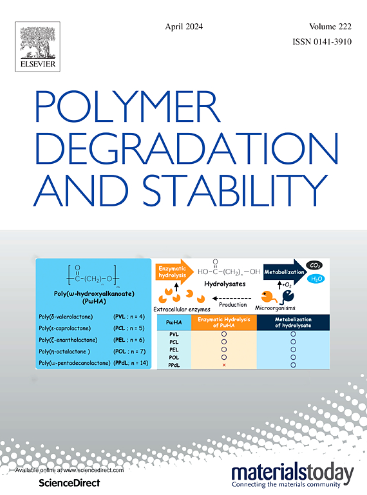Synergic effect between α-zirconium phosphate nanohybrid and aluminum hypophosphite to achieve eco-friendly high fire safety and mechanical strength
IF 6.3
2区 化学
Q1 POLYMER SCIENCE
引用次数: 0
Abstract
The simple addition of conventional flame retardants has made it difficult to achieve a balance between fire safety, smoke suppression, smoke toxicity and mechanical properties in flame-retardant polyurethanes. How to effectively integrate flame-retardant elements to synergize with traditional flame retardants while keeping the preparation process simple remains a major research challenge. Here, an in-situ supramolecular self-assembly organic-inorganic hybrid strategy was proposed. α-ZrP as an assembly aid, phosphorus-nitrogen integrated two-dimensional nanosheets (ZAMP) was prepared to work synergistically with aluminum hypophosphite (AHP), enhancing fire safety, smoke suppression, and anti-dripping properties of thermoplastic polyurethane (TPU). Due to the radical scavenging, gas dilution and physical barrier effects, and catalytic carbonization promoted by the 2D hybrid nanosheets, the flame-retardant polyurethane achieves a V0 rating in UL-94, self-extinguishes quickly without melt dripping, and exhibits a high limiting oxygen index (27.5 %), along with reduced peak heat release rate (74.8 %) and peak smoke production rate (54.55 %). Compared to single AHP addition (TPU/7 %AHP), TPU/6 %AHP/1 %ZAMP shows enhanced fire safety, lower smoke toxicity and better retention of mechanical properties. This straightforward supramolecular self-assembly flame-retardant strategy, using α-ZrP as an anchoring layer, provides new insights into designing highly effective nano flame-retardant synergists with broad fire protection performance.

求助全文
约1分钟内获得全文
求助全文
来源期刊

Polymer Degradation and Stability
化学-高分子科学
CiteScore
10.10
自引率
10.20%
发文量
325
审稿时长
23 days
期刊介绍:
Polymer Degradation and Stability deals with the degradation reactions and their control which are a major preoccupation of practitioners of the many and diverse aspects of modern polymer technology.
Deteriorative reactions occur during processing, when polymers are subjected to heat, oxygen and mechanical stress, and during the useful life of the materials when oxygen and sunlight are the most important degradative agencies. In more specialised applications, degradation may be induced by high energy radiation, ozone, atmospheric pollutants, mechanical stress, biological action, hydrolysis and many other influences. The mechanisms of these reactions and stabilisation processes must be understood if the technology and application of polymers are to continue to advance. The reporting of investigations of this kind is therefore a major function of this journal.
However there are also new developments in polymer technology in which degradation processes find positive applications. For example, photodegradable plastics are now available, the recycling of polymeric products will become increasingly important, degradation and combustion studies are involved in the definition of the fire hazards which are associated with polymeric materials and the microelectronics industry is vitally dependent upon polymer degradation in the manufacture of its circuitry. Polymer properties may also be improved by processes like curing and grafting, the chemistry of which can be closely related to that which causes physical deterioration in other circumstances.
 求助内容:
求助内容: 应助结果提醒方式:
应助结果提醒方式:


